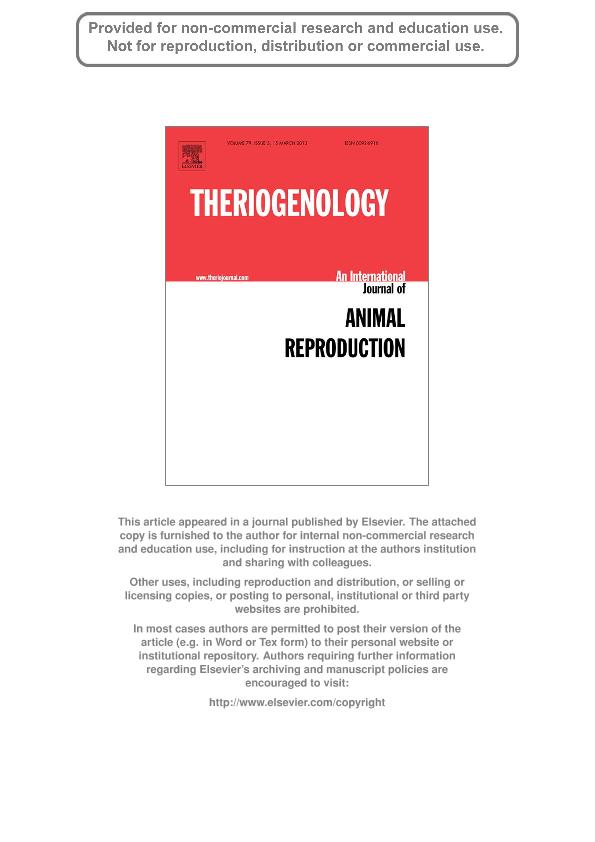Mostrar el registro sencillo del ítem
dc.contributor.author
Piccardi, Mónica Belén

dc.contributor.author
Capitaine Funes, A.
dc.contributor.author
Balzarini, Monica Graciela

dc.contributor.author
Bo, Gabriel Amilcar
dc.date.available
2015-10-01T18:59:11Z
dc.date.issued
2013-03
dc.identifier.citation
Piccardi, Mónica Belén; Capitaine Funes, A.; Balzarini, Monica Graciela; Bo, Gabriel Amilcar; Some factors affecting the number of days open in Argentinean dairy herds; Elsevier Science Inc.; Theriogenology; 79; 5; 3-2013; 760-765
dc.identifier.issn
0093-691X
dc.identifier.uri
http://hdl.handle.net/11336/2269
dc.description.abstract
The objective of this study was to estimate the relative contribution of factors affecting how quickly cattle become pregnant in Argentine dairy herds. Data from 76,401 cows from 249 dairy herds were analyzed. A hazard model was used to explore days open (DO). The factors considered were milk yield, lactation number, calving season, and breeding technique (i.e., type of service: artificial insemination [AI], or combined service). Cows with lower milk yield had 1.09 to 1.38 higher likelihood to become pregnant than those with higher milk yield (P < 0.0001). The number of DO increased linearly with an increasing number of lactations (P < 0.0001). Cows calving in fall-winter had a shorter interval to conception than those calving in summer. The hazard rate for combined service was 1.27; therefore, cows with combined service were more likely to become pregnant during the observation period than those bred by AI. The difference in DO between cows of high versus low milk yield was smaller when dairies used AI as the main breeding technique than when they used combined service. Furthermore, dairies using mainly combined service had lower milk yield (5693.7 L) than those using mainly AI (7684.4 L). Although lactation number and calving season contributed to explain the number of DO, the influence of production level, the type of service, and the interaction between them was also associated with reproductive efficiency in Argentine dairy herds.
dc.format
application/pdf
dc.language.iso
eng
dc.publisher
Elsevier Science Inc.

dc.rights
info:eu-repo/semantics/openAccess
dc.rights.uri
https://creativecommons.org/licenses/by-nc-nd/2.5/ar/
dc.subject
ARTIFICIAL INSEMINATION
dc.subject
HAZARD MODEL
dc.subject
MILK YIELD
dc.subject
NONPREGNANT COWS
dc.subject
REPRODUCTIVE PERFORMANCE
dc.subject.classification
Producción Animal y Lechería

dc.subject.classification
Producción Animal y Lechería

dc.subject.classification
CIENCIAS AGRÍCOLAS

dc.title
Some factors affecting the number of days open in Argentinean dairy herds
dc.type
info:eu-repo/semantics/article
dc.type
info:ar-repo/semantics/artículo
dc.type
info:eu-repo/semantics/publishedVersion
dc.date.updated
2016-03-30 10:35:44.97925-03
dc.journal.volume
79
dc.journal.number
5
dc.journal.pagination
760-765
dc.journal.pais
Estados Unidos

dc.journal.ciudad
Atlanta
dc.description.fil
Fil: Piccardi, Mónica Belén. Universidad Nacional de Córdoba. Facultad de Ciencias Agropecuarias. Departamento de Desarrollo Rural. Area de Estadística y Biometría; Argentina
dc.description.fil
Fil: Capitaine Funes, A.. DAIRYTECH S.R.L; Argentina
dc.description.fil
Fil: Balzarini, Monica Graciela. Universidad Nacional de Córdoba. Facultad de Ciencias Agropecuarias. Departamento de Desarrollo Rural. Area de Estadística y Biometría; Argentina. Consejo Nacional de Investigaciones Científicas y Técnicas. Centro Científico Tecnológico Córdoba; Argentina
dc.description.fil
Fil: Bo, Gabriel Amilcar. Instituto de Reproduccion Animal Córdoba; Argentina. Universidad Nacional de Villa María. Instituto Académico Pedagógico de Ciencias Básicas y Aplicadas; Argentina
dc.journal.title
Theriogenology

dc.relation.alternativeid
info:eu-repo/semantics/altIdentifier/url/http://www.sciencedirect.com/science/article/pii/S0093691X12006401
dc.relation.alternativeid
info:eu-repo/semantics/altIdentifier/doi/http://dx.doi.org/10.1016/j.theriogenology.2012.11.032
Archivos asociados
